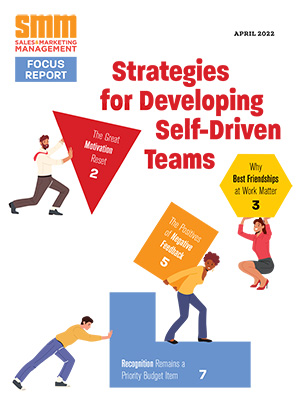
If all commissioned salespeople have the same opportunity to make more money, why don’t they? Why doesn’t every commissioned salesperson max out his or her comp plan?
The answer, says Tim Houlihan, vice president of reward systems at BI Worldwide (BIWorldwide.com), is deceptively simple, and it’s found in what behavioral economists call the hedonic treadmill. The short explanation is this: whatever level of income you have and the effort you exert to earn it becomes the norm. To earn more would require working harder and most people are, well, pretty complacent. All people say they want to earn more money but very few say they will work harder to earn more.
The hedonic treadmill is similar to being on a real treadmill. At first you feel fine. After a while, you begin to feel fatigued. After several hours, the steps become normal and you almost forget about the constant motion of one foot in front of the other. The same is true with incentive programs, Houlihan says. If you run the same program with the same rules on the same products with the same rewards month after month, your salespeople will stop paying attention. Changing things up helps re-energize and refocus your efforts.
He offers three tips for improving the effectiveness of your sales incentives:
Change the rules. Stack ranking is great occasionally but after a while, the folks on the south side of the winner’s circle will stop paying attention to your “Top 10 Go To Hawaii” contest. By using a stack ranking one quarter and individual objectives the next quarter, your salespeople will think about their business in light of the new rules. That consideration is a tiny act of engagement that could lead them to working harder and delivering greater results for you.
Change the rewards. Many sales managers believe that sales reps are coin operated so they begin incentive conversations with cash, cash and more cash. But if more cash were the answer, why wouldn’t your commissioned salespeople already be working harder to earn more? Mix it up by using different rewards: dinner with the SVP of Sales, a weeklong getaway at the company’s condo on the Big Island or points that can be redeemed for a 70-inch OLED curved-screen television, a Calloway XR Pro or a smart watch. They may be able to afford to buy those things with their own money, but they won’t. You’ll give them bragging rights when they pull the new driver out of their bag and their golf partners wonder where they got it. “My company gave it to me for being a top performer.” The sales rep gets the glory and you get the incremental performance required to earn it.
Change the focus. The problem with focus is that it’s difficult to maintain for long periods of time. Asking your reps to sell more of the new, high-margin widget month after month is fatiguing. Rather than a monthly contest that rewards reps for selling Product A, consider changing the emphasis every so often. You could switch the contest to reward them for selling other important products or for increasing margin or for selling partner products to keep things fresh. The reps will give you more effort in part because you’re changing things up. This allows them to naturally adjust their focus and you will benefit from re-energized reps with each new contest.



